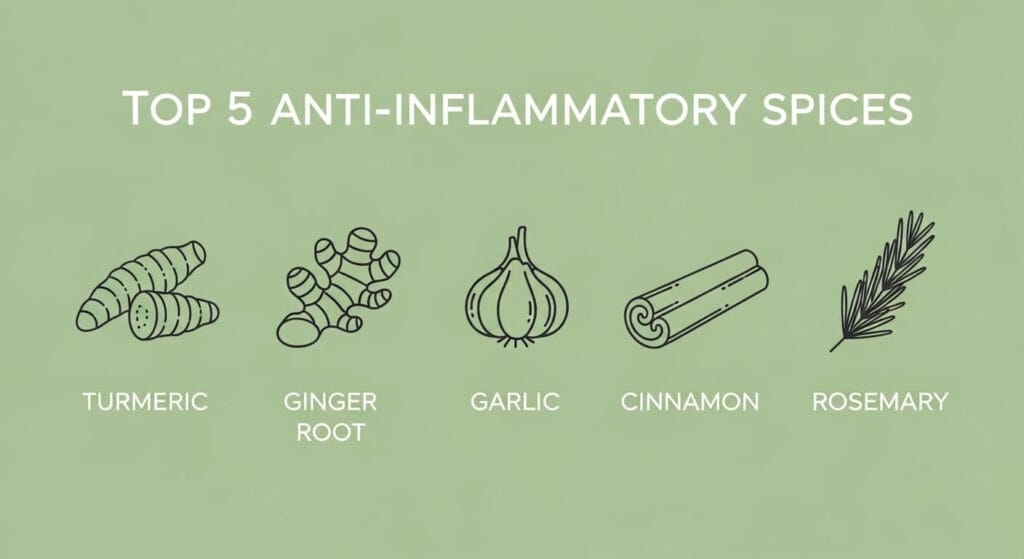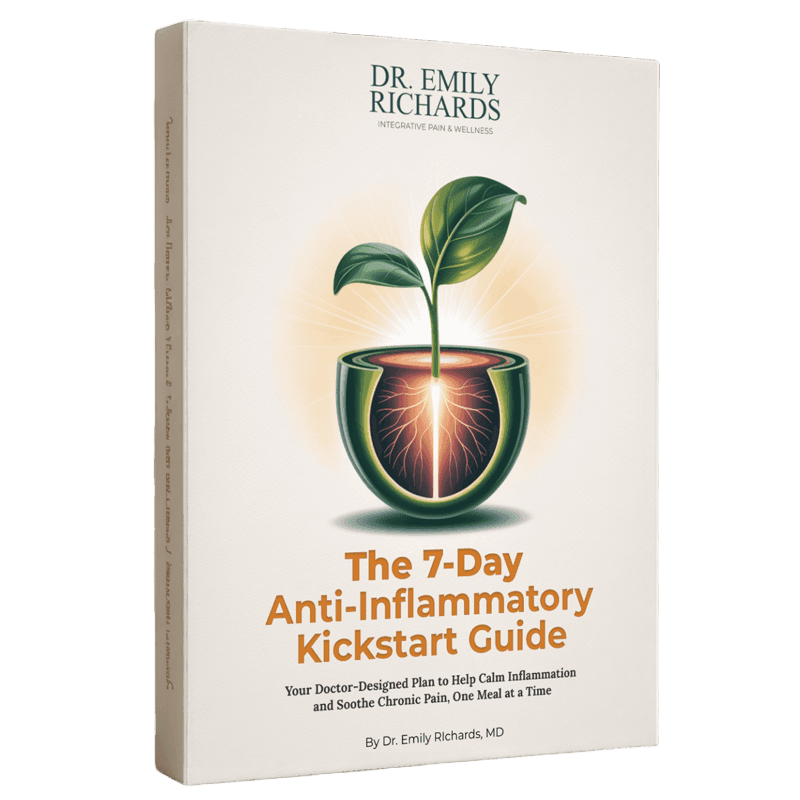In my journey through medicine and my own recovery, I learned a profound lesson: the most powerful pharmacy is often your own kitchen. The question isn’t just what pill to take, but what food to eat.
“Food as medicine” isn’t a trend; it’s a scientific reality.
Chronic, low-grade inflammation is the smoldering fire behind many persistent pain conditions. While medication can dampen the flames, a consistent anti-inflammatory diet helps reduce the fuel source itself. But where do you even start? The advice can feel overwhelming.
That’s why I’ve created this simple, evidence-based anti-inflammatory grocery list. Think of it not just as a list, but as a new way of looking at your plate—a toolkit for healing from the inside out.
Key Takeaways: Your Anti-Inflammatory Shopping Guide
- The Goal: To reduce chronic, low-grade inflammation—a key driver of persistent pain—by choosing foods that calm the body’s inflammatory response.
- Foods to Embrace: Focus on adding fatty fish (like salmon), colorful fruits and vegetables (especially leafy greens and berries), nuts, seeds, and healthy fats like extra virgin olive oil to your cart.
- Foods to Limit: The most common culprits that fuel inflammation are sugary foods and drinks, refined carbohydrates (like white bread), processed meats, and certain vegetable oils high in omega-6.
Table of Contents
Prefer to Listen? An Audio Overview
For a conversational deep dive into this topic, press play below for the complete audio discussion with our hosts.
Runtime: 3 minutes
View Full Audio Transcript
Narrator: Welcome. Today, we’re talking about one of the most practical tools for pain management: the anti-inflammatory diet. Dr. Emily, our listeners are overwhelmed with information. They want to know, what is the single most powerful anti-inflammatory food they can buy?
Dr. Emily Richards: That’s the question everyone asks, and it’s a great one. While there’s no single magic bullet, if I had to pick one category, it would be fatty fish like wild-caught salmon. The omega-3 fatty acids they contain, specifically EPA and DHA, are incredibly potent at resolving inflammation. Think of them as the fire department for the smoldering fire of chronic pain.
Narrator: So, fatty fish is number one. What’s a simple rule of thumb for produce?
Dr. Emily Richards: It’s simple: eat the rainbow. The deep, rich colors in foods like blueberries, spinach, and beets come from antioxidants and polyphenols. These compounds are like a shield for your cells, protecting them from the stress that inflammation causes. The more color on your plate, the more protection you’re getting.
Narrator: The research also shows a lot of confusion around specific foods. For example, people constantly ask: is coffee inflammatory? Are eggs bad?
Dr. Emily Richards: This is such a critical point. For the vast majority of people, the answer is no. High-quality coffee, in moderation, is actually rich in anti-inflammatory polyphenols. Eggs are a fantastic source of nutrients. The key is to focus on progress, not perfection. I teach my patients the 80/20 rule. 80% of the time, fill your plate with the foods we’ve discussed. The other 20% allows for real life. A sustainable approach is far more effective than a restrictive diet you can’t maintain.
Narrator: That’s very reassuring. On the flip side, what is the number one food that fuels inflammation that people should try to limit?
Dr. Emily Richards: Without a doubt, it’s excess sugar, especially from sugary drinks and refined carbohydrates like white bread and pastries. These foods can cause rapid spikes in blood sugar, which can trigger the release of inflammatory messengers in the body. Reducing these is often the fastest way to feel a difference.
Narrator: So, the big takeaway is to focus on adding more whole, colorful foods and reducing processed sugars.
Dr. Emily Richards: Exactly. Don’t try to change everything overnight. Start by adding a handful of spinach to your eggs, or swapping a sugary snack for a handful of walnuts. Small, consistent changes are what build new habits and lead to significant, long-term relief. It’s about using your grocery cart as a powerful tool for healing.
Understanding Inflammation’s Role in Pain
Inflammation is your body’s natural response to injury or infection—a crucial part of healing. Acute inflammation is the hero that rushes in to protect and repair. Chronic inflammation, however, is when that response never fully shuts off. This persistent state of alert can damage healthy tissues and is a key driver of the pain and stiffness associated with many chronic conditions. The foods we eat can either fuel this fire or help to calm it. Adopting an anti-inflammatory diet is a foundational part of a holistic, mind-body approach to wellness.
| Foods to Embrace (Anti-Inflammatory) | Foods to Limit (Pro-Inflammatory) |
|---|---|
| Fatty Fish (Salmon, Sardines) | Sugary Drinks (Soda, Sweetened Teas) |
| Leafy Greens (Spinach, Kale) | Refined Carbs (White Bread, Pastries) |
| Berries (Blueberries, Strawberries) | Processed Meats (Hot Dogs, Sausage) |
| Nuts & Seeds (Walnuts, Almonds) | Certain Vegetable Oils (Corn, Soy Oil) |
| Olive Oil (Extra Virgin) | Trans Fats (Margarine, Fried Foods) |
Your Anti-Inflammatory Grocery List: Foods to Embrace
Focus on adding these nutrient-dense, inflammation-fighting foods to your daily meals.
- Fatty Fish: Rich in omega-3 fatty acids (EPA and DHA), which are potent anti-inflammatory agents.
- Examples: Salmon, mackerel, sardines, herring.
- Leafy Greens: Packed with antioxidants and vitamins that protect cells from inflammatory damage.
- Examples: Spinach, kale, Swiss chard, collard greens.
- Berries: Loaded with antioxidants called anthocyanins, which have powerful anti-inflammatory effects.
- Examples: Blueberries, strawberries, raspberries, blackberries.
- Nuts and Seeds: A great source of healthy fats, fiber, and antioxidants.
- Examples: Walnuts, almonds, flaxseeds, chia seeds.
- Olive Oil: Extra virgin olive oil contains oleocanthal, a compound with effects that have been compared to ibuprofen.
- How to Use: Use for salad dressings and low-heat cooking.
- Cruciferous Vegetables: Contain sulforaphane, an antioxidant that fights inflammation.
- Examples: Broccoli, cauliflower, Brussels sprouts, kale.
- Colorful Fruits & Veggies: The deeper the color, the higher the antioxidant content.
- Examples: Beets, sweet potatoes, bell peppers, oranges.
- Spices & Herbs: Many contain powerful anti-inflammatory compounds.
- Examples: Turmeric (curcumin), ginger, garlic, cinnamon, rosemary.

Foods That Can Fuel Inflammation: What to Limit
Reducing or eliminating these foods can be just as important as adding the good ones.
- Sugary Foods & Beverages: Excess sugar can trigger the release of inflammatory messengers.
- Includes: Soda, candy, pastries, many breakfast cereals.
- Refined Carbohydrates: These have a high glycemic index, which can fuel inflammation.
- Includes: White bread, white pasta, white rice.
- Processed & Red Meats: High in saturated fats and advanced glycation end products (AGEs), which are highly inflammatory.
- Includes: Hot dogs, sausage, bacon, steak.
- Trans Fats & Certain Vegetable Oils: Found in many processed foods, these fats promote inflammation.
- Avoid: Margarine, shortening, and oils high in omega-6 like corn, soy, and sunflower oil.
Simple Anti-Inflammatory Meal Ideas & Recipes
A list is only as good as the meals you make with it. Knowing what to buy is the first step; turning it into delicious, healing food is the next. Here’s how to easily use these ingredients.
1. Morning Anti-Inflammatory Smoothie
- Ingredients: 1 cup spinach, 1/2 cup frozen blueberries, 1/2 avocado, 1 tbsp chia seeds, 1/2-inch fresh ginger, 1 cup unsweetened almond milk.
- Directions: Blend all ingredients until smooth.
2. Simple Salmon & Broccoli Dinner
- Ingredients: 1 salmon fillet, 2 cups broccoli florets, 1 tbsp olive oil, 1 clove minced garlic, salt, pepper, lemon.
- Directions: Toss broccoli with olive oil, garlic, salt, and pepper. Roast at 400°F (200°C) for 15 minutes. Add the salmon fillet to the pan, season it, and roast for another 10-12 minutes, or until cooked through. Squeeze fresh lemon over everything before serving.
3. Turmeric “Golden Milk” Tea
- Ingredients: 1 cup unsweetened almond or coconut milk, 1/2 tsp ground turmeric, 1/4 tsp ground ginger, a pinch of black pepper (helps absorption of curcumin), optional: 1 tsp maple syrup or honey.
- Directions: Gently warm all ingredients in a small saucepan, whisking to combine. Do not boil. Pour into a mug and enjoy before bed.
Frequently Asked Questions
What is the single most powerful anti-inflammatory food?
While many foods are powerful, fatty fish like wild-caught salmon is arguably at the top of the list due to its high concentration of EPA and DHA, omega-3 fatty acids that are proven to resolve inflammation. Turmeric is another strong contender due to its active compound, curcumin.
I hear so much conflicting information. Do I have to give up foods like eggs, coffee, or potatoes?
This is a critical question. For most people, the answer is no. While some individuals may have specific sensitivities, foods like eggs, coffee, and potatoes are not inherently inflammatory for the general population. The goal is progress, not perfection. Focus on an 80/20 approach: 80% of the time, fill your plate with foods from the anti-inflammatory list. This sustainable approach is far more effective long-term than a restrictive diet you can’t maintain.
How long does it take to feel a difference from an anti-inflammatory diet?
This varies greatly between individuals. Some people may notice a reduction in stiffness and pain within a couple of weeks of making consistent changes. For others, it may take a month or more for the cumulative effects to become apparent. Consistency is the key.
Disclaimer: The content provided by Dr. Emily Richards is for informational and educational purposes only and does not constitute medical advice. Always consult with your healthcare provider for any health concerns or before making any changes to your treatment plan.
References
View Full List of Scientific References
- Ricker MA, Haas WC. Anti-Inflammatory Diet in Clinical Practice: A Review. Nutr Clin Pract. 2017 Jun;32(3):318-325. doi: 10.1177/0884533617700353. Epub 2017 Mar 28. PMID: 28350517. https://pubmed.ncbi.nlm.nih.gov/28350517/
- Florkowski M, Abiona E, Frank KM, Brichacek AL. Obesity-associated inflammation countered by a Mediterranean diet: the role of gut-derived metabolites. Front Nutr. 2024 Jun 24;11:1392666. doi: 10.3389/fnut.2024.1392666. PMID: 38978699; PMCID: PMC11229823. https://pmc.ncbi.nlm.nih.gov/articles/PMC11229823/
- Shah R, Shah N, Shah P. Excessive intake of sugar: An accomplice of inflammation. Immunobiology. 2022;227(4):152283. doi: 10.1016/j.imbio.2022.152283. PMID: 36098001; PMCID: PMC9471313.
- Office of Dietary Supplements – Omega-3 Fatty Acids. National Institutes of Health. Updated August 29, 2024. Accessed August 29, 2025. https://ods.od.nih.gov/factsheets/Omega3FattyAcids-HealthProfessional
- Poerio E, Guglielmi F, Mennella I, et al. Targeting Inflammation by Anthocyanins as the Novel Therapeutic Potential for Chronic Diseases: An Update. Nutrients. 2022;14(5):952. doi: 10.3390/nu14050952. PMID: 35276634; PMCID: PMC8304181.
- Beauchamp GK, Keast RS, Morel D, et al. Oleocanthal, a Phenolic Derived from Virgin Olive Oil: A Review of the Beneficial Effects on Inflammatory Disease. Int J Mol Sci. 2014;15(10):18533-18549. doi: 10.3390/ijms151018533. PMID: 25321977; PMCID: PMC4139846.
- Guerrero-Beltrán CE, Calderón-Oliver M, Pedraza-Aboytes G, et al. Sulforaphane—A Compound with Potential Health Benefits for Disease Prevention and Treatment: Insights from Pharmacological and Toxicological Experimental Studies. Molecules. 2023;28(13):5244. doi: 10.3390/molecules28135244. PMID: 37444844; PMCID: PMC10886109.
- Daily JW, Yang M, Park S. Efficacy of Turmeric Extracts and Curcumin for Alleviating the Symptoms of Joint Arthritis: A Systematic Review and Meta-Analysis of Randomized Clinical Trials. J Med Food. 2016 Aug;19(8):717-29. doi: 10.1089/jmf.2016.3705. PMID: 27533649; PMCID: PMC5003001.

Start Healing from the Inside Out
Download my FREE 7-Day Anti-Inflammatory Kickstart Guide. It’s a simple, doctor-designed plan to help you reduce inflammation and soothe pain, one meal at a time.

